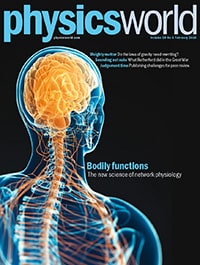[brightcove videoID=ref:phw.live/2016-02-01-february-new-issue/1 playerID=106573614001 height=330 width=500]
By Matin Durrani
Welcome to the February 2016 issue of Physics World magazine.
As I explain in the video above, this month we have a package of articles looking at some of the issues surrounding peer review, including a news-analysis piece by Physics World news editor Michael Banks, who talks to a range of figures in physics and publishing with views on this subject.
Our cover feature this month is on the new interdisciplinary science of “network physiology”. Elsewhere in the issue, John Campbell from the University of Canterbury in New Zealand looks at Rutherford’s secret work in the First World War using sonar to spot submarines, while science writer Matthew Francis looks at efforts to rewrite the rules of gravity.
If you’re a member of the Institute of Physics (IOP), you can now enjoy immediate access to the new issue with the digital edition of the magazine on your desktop or on any iOS or Android smartphone or tablet via the Physics World app, available from the App Store and Google Play. If you’re not yet in the IOP, you can join as an IOPimember for just £15, €20 or $25 a year to get full access to Physics World both online and through the apps.
For the record, here’s a run-down of what else is in the issue.
 • Peer review under the spotlight – Peer review has been the backbone of scientific publishing for centuries, but many feel that the time has come for the system to be reformed. Michael Banks weighs up the options
• Peer review under the spotlight – Peer review has been the backbone of scientific publishing for centuries, but many feel that the time has come for the system to be reformed. Michael Banks weighs up the options
• Peer review’s value – Robert P Crease looks at why peer review works, despite its flaws
• Open refereeing – John Harnad argues that introducing payment for referees
and making their names public would improve the quality and credibility of peer review
• Might gravity have mass? – The accelerating expansion of the universe could be explained by modifying general relativity so that gravity has mass – or so thinks a small group of physicists. Matthew Francis reports
• Revealing the network within – Can we map all the information being circulated in the human body, and would doing so be any use? Jon Cartwright explores the emerging interdisciplinary field of “network physiology”
• Rutherford’s war – Seagulls, sea lions and the comic-book hero Professor Radium were all recruited to fight the threat of submarines during the First World War. But as John Campbell explains, it was Ernest Rutherford who led the way a century ago in using acoustics to deter these deadly craft
• How black holes saved relativity – Chanda Prescod-Weinstein reviews Black Hole: How an Idea Abandoned by Newtonians, Hated by Einstein, and Gambled on by Hawking Became Loved by Marcia Bartusiak
• ‘Big science’ begins – David Wark reviews Big Science: Ernest Lawrence and the
Invention that Launched the Military-Industrial Complex by Michael Hiltzik
• Animal magnetism – Steve Roberts explains how a novel business idea – a specialist MRI scanner for horses – led his physics career down an unusual and rewarding path
• Once a physicist – Robert Lang is an origami artist and author of several books on origami techniques
• A physics lab inside your head – A-level physics student Maria Violaris at Altrincham Girls’ Grammar School, UK, looks at thought experiments in physics



